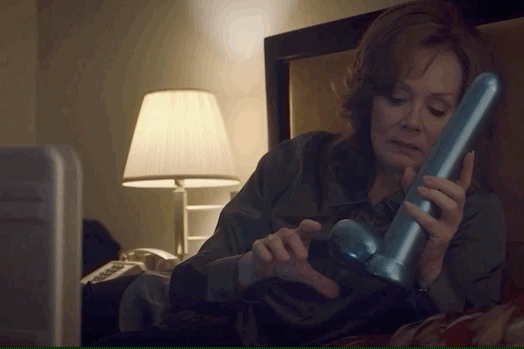
After two episodes spent following Regina King’s masked cop, HBO’s Watchmen suddenly switches perspectives in its third episode to focus on a new character: Jean Smart’s FBI agent, who, for those who might have read Alan Moore and Dave Gibbons’s original graphic novel, isn’t that new after all. Meet Laurie Blake, a nihilistic joke-teller, who, as we learn over the course of the episode, is the older version of one of the graphic novel’s main characters, Laurie Juspeczyk, a.k.a. Silk Spectre. In the book, Laurie inherits that title from her mother, along with a lot of other baggage, and while she’s involved in a lot of the plot, she’s much more of a passive figure than the character Jean Smart is playing in the TV show. According to Lila Byock, who co-wrote this week’s episode with creator Damon Lindelof, that’s intentional.
“We knew very early on that we kind of wanted to redeem Laurie,” Byock said. “We really wanted to play with the idea of, who is this character when she’s on her own? And the one thing we knew for sure was that she was going to be funny.”
To that end, we meet this version of Laurie through her jokes, which she tells over the course of a phone call from Earth to Dr. Manhattan-on-Mars that the episode keeps cutting back to. The phone call provides a lot of information about Laurie and the world of Watchmen, especially if you haven’t read the book: that Dr. Manhattan is her ex; that he, Dan Dreiberg (a.k.a. Nite Owl), Rorschach, and Ozymandias all had differing approaches to heroism; and that Laurie pretty much hates all of them. That last development comes out of a lot of what Laurie is subjected to over the course of the book’s plot.
“She doesn’t have much to work with in the book,” Byock said. “She gets pushed into costume adventuring by her mom. She doesn’t even have her own identity as a costume adventurer. When she’s 16, she becomes involved in a relationship with Doctor Manhattan, which occupies her entire adult life until she turns 30, when she leaves Manhattan for Dan Dreiberg — again, another costumed adventurer.”
There’s a lot of information about how Laurie has changed by the time of the TV series in the name she’s currently going by, Laurie Blake, and the fact that she’s telling jokes in the first place. In the book, Laurie discovers that Eddie Blake, a jingoistic, sociopathic costumed adventurer known as the Comedian, is her father; that he attempted to rape her mother, Sally Jupiter (the original Silk Spectre); and that Sally eventually fell in love with him. For the TV series, the writers decided that Laurie is still trying to come to grips with her relationship with her father.
“Even though she resents him in the abstract for what he did to her mother,” Byock said, “She knows that her mother also did care about him in some weird, fucked-up way, and that some part of him is her.” As revealed in the additional materials HBO has put out online about Watchmen, the writers also decided that Laurie took on the name “the Comedienne” after the events of the book, before she and Dan Dreiberg were arrested for vigilantism in the 1990s. “Taking the name ‘the Comedienne’ and taking his last name, Laurie Blake,” Byock said. “That’s all her attempt to grapple with ‘what part of me is him?’”
So, why is this version of Laurie Blake working with the FBI now? The plot-based answer is that she and Dreiberg were arrested in the ’90s, and she decided to work with the FBI, while he refused. (The implication of Senator Keane’s offer to free the owl Laurie keeps in a cage is that he’ll pardon Dreiberg.) But thematically, Laurie’s position puts her into conflict with Angela Abar, and introducing Laurie now allowed the show to provide a “genuine adversary” to its main character, according to Byock.
“We were watching a lot of Killing Eve in the writers room during the period of time when we’re working on this episode,” Byock says. “We wanted to capture that show’s lightning in the scene between Laurie and Angela in the mausoleum.”
While Laurie presents as steely on the outside, she’s also a lot more conflicted than she lets on, especially in terms of her romantic and sexual attachment to the heroes she pretends to hate (or at least one big blue hero). Yes, we’re talking about the big blue dildo that resembles Dr. Manhattan’s penis that we discover Laurie has been carrying around in her Halliburton for the whole episode.
“I think I pitched that as a joke!” Byock says, “and Damon called my bluff, and then it was like, oh, we’re definitely doing that. Because I worked with him on The Leftovers [which made several gags about Justin Theroux’s character’s penis], I by that point had a pretty clear sense of what kind of jokes were going to land.”
To Byock, the blue dildo represents Laurie’s own kind of “nostalgia for her sexual past.” In the comic, Doctor Manhattan, the former Jon Osterman, starts a relationship with Laurie when she’s very young, and Laurie spends a lot of the book trying to convince him to invest in the lives of people on Earth. In Byock’s mind, Laurie Blake had this object custom-made, and the fact that she keeps it alongside an Esquire cover of herself and Doctor Manhattan together is also revealing.
“She’s somebody who is so insistent about not being nostalgic and not having any reverence for her past as a costumed adventurer, and yet when she is all alone, we learn that she gets off literally by thinking about her past,” Byock says. It’s the opposite of the way she deals with her FBI underling Dale Petey’s (Dustin Ingram) questions about her past at work, “although she does have him put on his mask when they have sex.”
Figuring out the right understanding of Laurie’s sexual and romantic attachment to the past also ended up being a key part of the casting process, at least in terms of landing the formidable Jean Smart to play the role. When the writers learned that Smart was available, Lindelof dispatched Byock to take the actor out for martinis and convince her to take the job.
“It was the greatest moment of my life as a television writer,” Byock says. “I think she was inclined to do it. She just wanted to understand what it is that’s driving Laurie, what is this complicated mixture between someone who is both at war with her past and erotically interested in her past. She just wanted to hear me talk about it in a convincing way, over vodka and vermouth.”
Byock, who’s previously written on The Leftovers, Castle Rock, and Manhattan, was herself very invested in figuring out this version of Laurie, to the extent that when the writers discussed the character in the room, “I had really passionate opinions about her.” Smart was convinced, and joined the show, and took this new version of Laurie to the screen. “I saw Jean recently when we were doing some after-the-episode talkback stuff, and it happened to be her birthday,” Byock said. “The production surprised her with a giant cake in the shape of a Halliburton briefcase, so that was pretty exciting.”



